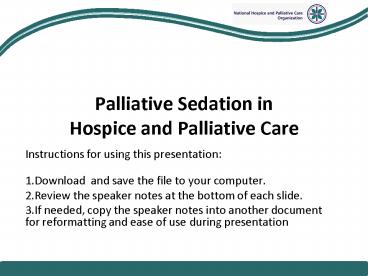Palliative Sedation in Hospice and Palliative Care PowerPoint PPT Presentation
1 / 19
Title: Palliative Sedation in Hospice and Palliative Care
1
Palliative Sedation in Hospice and Palliative
Care
- Instructions for using this presentation
- Download and save the file to your computer.
- Review the speaker notes at the bottom of each
slide. - If needed, copy the speaker notes into another
document for reformatting and ease of use during
presentation
2
Palliative Sedation in Hospice and Palliative
Care
- National Hospice and Palliative Care Organization
Ethics Committee - July 2012
3
Goals
- Define palliative sedation
- Discuss ethical justification
- Discuss implementation issues
- Review relevant organizational policies and
procedures - Explore process using case studies
4
Define PST
- Palliative sedation is
- lowering of patient consciousness using sedative
medications with the - intent of limiting patient awareness of
suffering - when suffering is otherwise intractable and
intolerable (Morita et al., 2002 Kirk Mahon,
2010).
5
Process and Conditions of Sedation
- Use of sedatives via evidence-based protocol
(Cherny et al.) - Appropriateness considering patients trajectory
toward death - Proportionate sedation only to the degree
necessary to make suffering tolerable as defined
by patient - Reversible
6
Ethical Justification
- Nonmaleficence
- Do no harm
- Preventing/reducing harm
- Beneficence
- Benefitting patient/family
- Conceive of benefit in a way informed by
patient/family values/goals - Autonomy
- Honoring wishes/preferences of patient/family
- Removing barriers/threats to patients sense of
self
7
Confusion about Ethical Justification
- Assisted suicide debate
- Doctrine of double effect
- Sedation the proximate cause of death
- Distinct from high-dose opioid use
8
Ethical Implementation
- Thoughtfully and thoroughly developed policy and
procedures - Rigorous interdisciplinary assessment
- Excellent but unsuccessful interdisciplinary
interventions prior to initiation - Clear communication with patient and family
- Careful, expert implementation
- Accurate and complete documentation
9
Clinical Use
- Far end of palliative care continuum
- Part of interdisciplinary plan of care
- Revocable
- Only for unrelieved symptoms
10
Pediatric Considerations
- Appropriate for children
- Unrelieved distress
- Inadequately alleviated by other measures
11
Artificial Nutrition and Hydration
- Separate the decision for sedation from ANH and
other concomitant therapies - Consider clinical appropriateness for each
intervention - Patients have right to refuse invasive procedures
- Hospice and palliative care organizations have
responsibility to offer only therapies consistent
with their mission, scope of practice, expertise,
and policies and procedures
12
Who Decides?
- Patient autonomy and related rights
- Family involved in care planning
- Interdisciplinary team develops care plan with
patient and family - Advice from external ethics consultation may be
helpful - Advice from external clinicians may be helpful
13
When Death is not Imminent
- Relationship of sedation and voluntary intake of
food hydration - Does sedation preventing intake of food
hydration for gt10 days become contributing cause
of death? - Questions to consider
- Voluntary intake?
- Benefit/burden?
- Temporary sedation appropriate?
14
Organizational Policy and Procedure
- POLICY
- Definition of PST
- Indications for PST
- Clinical ethical rationale for PST
- Guidelines for patient, family, team assessment
support during and after PST - Guidelines for annual case review quality
improvement process
15
Organizational Policy and Procedure
- PROCEDURES
- Checklist for intractable intolerable symptoms
trialed/failed interventions - Checklist for patient/family education/consent
- Plan/rationale for continuing/not continuing ANH
- Evidence-based protocol for selection dosage of
sedative medication
16
Organizational Policy and Procedure
- PROCEDURES
- Checklist for ongoing support of family and team
during sedation - Evidence-based protocol for symptom assessment
during induction, regular assessment during
sedation to ensure level of suffering is
tolerable
17
Case Studies
- Case 1 Mr. Martin, 73-years old, has prostate
ca. - Case 2 Ms. North is 68 and has lung ca.
- Case 3 Ms. Smith is 22 years old and has a
peripheral neuroectodermal tumor that responded
poorly to treatment. - Case 4 Mr. George is in his late 50s and has
ALS. - Case 5 Ms. Lopez is in her mid-30s and has
cervical ca that has become metastatic to
multiple organs and to bone.
18
Bibliography
- Cherny, N Radbruch, L. European Association
for Palliative Care (EAPC) Recommended Framework
for the Use of Sedation in Palliative Care.
Palliative Medicine 23, no. 7 (2009) 581-593. - Kirk, T. Mahon, M. National Hospice and
Palliative Care Organization (NHPCO) Position
Statement and Commentary on the Use of Palliative
Sedation in Imminently Dying Terminally Ill
Patients. Journal of Pain Symptom Management
39, no. 5 (2010) 914-923.
19
Bibliography
- Maltoni, M., Scarpi, E., Rosati, M. et al.
Palliative Sedation in End-of-Life Care and
Survival A Systematic Review. Journal of
Clinical Oncology 30, no. 12 (2012) 1378-1383. - Morita, T., Tsuneto, S. Shima, Y. Definition
of Sedation for Symptom Relief A Systematic
Literature Review and a Proposal of Operational
Criteria. Journal of Pain Symptom Management
24, no. (2002) 447-453.

